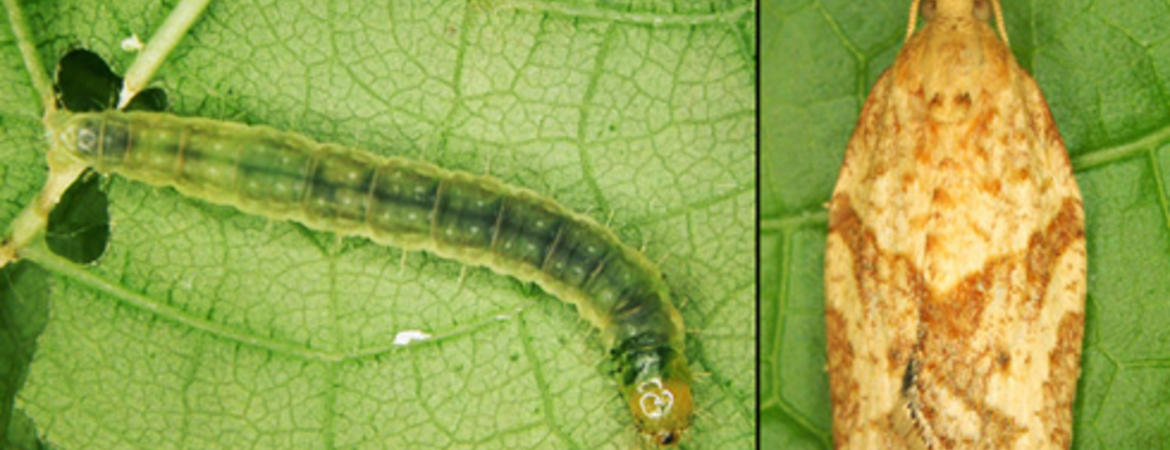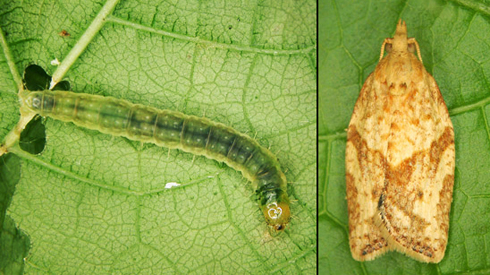
The Light Brown Apple Moth,
The situation: Light brown apple moth (LBAM) is a tortricid leafroller approximately ¼ inch in length that roll leaves into shelters. LBAM is native to Australia and has established in New Zealand, Hawaii, Ireland, New Caledonia and Great Britain. In March 2007, the presence of LBAM was confirmed in California and shipments of plant material have been restricted from California to other states in the USA and also within California from infested counties where LBAM has been detected to non-infested areas in California. The California Department of Food and Agriculture (CDFA) considers LBAM to be a Class A pest and has implemented an eradication program which primarily involves mating disruption pheromones and insecticide treatments.
Damage: LBAM has been recorded from over 2,000 different types of plants, encompassing 50 plant families. Host plants include deciduous tree fruits, subtropical fruits, berry fruits, ornamentals, and forest and shade trees. LBAM larvae feed on leaves and buds reducing photosynthetic rate, deforming growth patterns, which leads to general plant weakness and disfigurement. In grapes, apples, kiwifruit, plums, avocados, and citrus, LBAM larvae can feed directly on the fruit, and resulting feeding damage renders fruit unmarketable. Because of the economically important effects of larval feeding, LBAM has a high pest status in New Zealand and Australia because of zero tolerance requirements for presence in produce destined for the export markets.
Economic Impact: To date, the LBAM program has spent approximately $70 million in CDFA and USDA funds. If eradication is unsuccessful and LBAM establishes in California, the impact on increased production costs and crop losses for LBAM hosts could be over $133 million per year (as estimated by CDFA). Additionally, quarantine restrictions and export trade barriers will likely be devastating to some commodity industries. For example, Mexico and Canada implemented restrictions on a number of commodities from quarantined California counties in May and June 2007, respectively. Furthermore, LBAM has not established in any of the other states of the continental U.S, outside of California, therefore, other U.S. states would likely impose restrictions on the movement of potentially infested produce from California. These restrictions could severely impact the domestic marketing of California-grown agricultural products.
Distribution: In March 2007, LBAM was found in Alameda County in California. Infestations have since been found in thirteen counties located in California’s Central Coast and Bay Area communities, which are therefore under quarantine: Alameda, Contra Costa, Marin, Monterey, Napa, San Benito, San Francisco, San Mateo, Santa Barbara, Santa Clara, Santa Cruz, Solano and Sonoma.
Research: Foreign exploration efforts for LBAM natural enemies in southeastern Australia (the home range for this pest) commenced in November of 2007. Dr. N. Mills is currently conducting host specificity testing of two Australian parasitoids for potential release in California. Concurrent with this effort, UC and CDFA researchers have been monitoring LBAM populations to identify ongoing parasitism by egg, larval and pupal parasitoids presently occurring in California. It has been determined that LBAM eggs are being parasitized by two species of Trichogramma (Trichogramma fasciatum and Trichogramma platneri ), and larvae are being parasitized by several species of parasitoids. Additional work by Dr. K. Daane (UC Berkeley) is being done to determine what other leafroller species in the region are supporting these larval and pupal parasitoids that are presently parasitizing LBAM.
Want more? Go to the CISR website for more on the Light Brown Apple Moth
